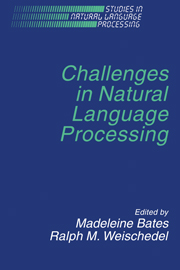Book contents
- Frontmatter
- Contents
- Preface
- Symposium participants
- Part I Challenging problems
- Part II Building a lexicon
- Part III Semantics and knowledge representation
- Part IV Discourse
- 7 Getting and keeping the center of attention
- 8 Surface structure, intonation, and discourse meaning
- Part V Spoken language systems
- Part VI Conclusion
- Author index
- Subject index
7 - Getting and keeping the center of attention
Published online by Cambridge University Press: 05 March 2010
- Frontmatter
- Contents
- Preface
- Symposium participants
- Part I Challenging problems
- Part II Building a lexicon
- Part III Semantics and knowledge representation
- Part IV Discourse
- 7 Getting and keeping the center of attention
- 8 Surface structure, intonation, and discourse meaning
- Part V Spoken language systems
- Part VI Conclusion
- Author index
- Subject index
Summary
Introduction
The present work investigates the contrastive discourse functions of a definite and a demonstrative pronoun in similar contexts of use. It therefore provides an opportunity to examine the separate contributions to attentional state (Grosz and Sidner, 1986) of two linguistic features – definiteness and demonstrativity – independently of pronominalization per se. The two pronouns, it and that, have clearly contrastive contexts of use, explained here in terms of distinct pragmatic functions. Certain uses of it are claimed to perform a distinctive cohesive function, namely, to establish a local center (that modifies rather than replaces the notion of a center). The crucial distinction between a local center and the Cb (backward-looking center) of the centering framework (cf. Sidner, 1983; Grosz et al., 1983; Grosz et al., 1986; Kameyama, 1986) is that there is only a single potential local center rather than an ordered set of Cfs (forward-looking centers). The local center is argued to constitute a reference point in the model of the speech situation in a manner analogous to 1st and 2nd person pronouns. In contrast, a deictic function is posited for apparently anaphoric uses of that whereby the attentional status of a discourse entity is changed, or a new discourse entity is constructed based on non-referential constituents of the linguistic structure. Because it is impossible to observe attentional processes directly, I present an empirical method for investigating discourse coherence relations. I analyze statistically significant distributional models in terms of three types of transitions in the cognitive states of conversational participants: expected transitions, unexpected transitions, and transitions with no relevant effect.
- Type
- Chapter
- Information
- Challenges in Natural Language Processing , pp. 179 - 227Publisher: Cambridge University PressPrint publication year: 1993
- 4
- Cited by



